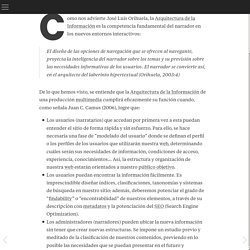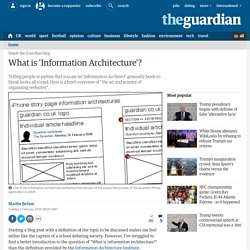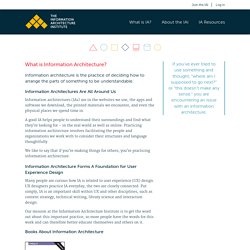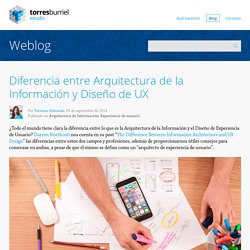

Construire l'arborescence de son site web. L’arborescence permet d’avoir une vision globale du site web et des parcours de navigation avant de réaliser les maquettes des pages principales.

Réaliser le plan de son site web est souvent un exercice très difficile. Il n’est jamais évident d’organiser du contenu, souvent plus hétérogène qu’on l’imagine au départ. Surtout, faire un plan, c’est hiérarchiser, faire des choix, ce qui peut prendre du temps et créer des discussions dans une équipe. C’est un exercice difficile, mais ô combien important. Sans une navigation bien pensée, un site web, aussi joli soit-il, a peu de chances d’atteindre ses objectifs. Arquitectura de la Información. Como nos advierte José Luis Orihuela, la Arquitectura de la Información es la competencia fundamental del narrador en los nuevos entornos interactivos: El diseño de las opciones de navegación que se ofrecen al navegante, proyecta la inteligencia del narrador sobre los temas y su previsión sobre las necesidades informativas de los usuarios.

El narrador se convierte así, en el arquitecto del laberinto hipertextual (Orihuela, 2003:4) Arquitectura. Arquitectura. What is 'Information Architecture'? Starting a blog post with a definition of the topic to be discussed makes me feel rather like the captain of a school debating society.

However, I've struggled to find a better introduction to the question of "What is information architecture? " than the definition provided by the Information Architecture Institute. We define information architecture as the art and science of organizing and labeling websites, intranets, online communities and software to support usability. Or as someone once put it to me: "You just draw boxes, don't you? ". Information architecture isn't just about drawing boxes. These solutions will be arrived at by research. A classic way to sum up information architecture is an image that appeared in 'the polar bear book' - "Information Architecture for the World Wide Web" by Louis Rosenfeld and Peter Morville.
At a micro level this can mean deciding that products on a search page should be ordered by price rather than by name. What is Information Architecture? Information Architectures Are All Around Us Information architectures (IAs) are in the websites we use, the apps and software we download, the printed materials we encounter, and even the physical places we spend time in.

A good IA helps people to understand their surroundings and find what they’re looking for – in the real world as well as online. Practicing information architecture involves facilitating the people and organizations we work with to consider their structures and language thoughtfully. We like to say that if you’re making things for others, you’re practicing information architecture. Information Architecture Forms A Foundation for User Experience Design Many people are curious how IA is related to user experience (UX) design. Our mission at the Information Architecture Institute is to get the word out about this important practice, so more people have the words for this work and can therefore better educate themselves and others on it.
Amazon. Arquitectura de Información. AugSep10 Brown. The Difference Between Information Architecture and UX Design. Newsletter Sign Up Original UX articles Curated Resources Never miss an issue!

Information architects form the blueprints of the web Next to explaining what I do for a living, the second question I most frequently hear is: “What’s the difference between Information Architecture and User Experience?” Information Architecture, according to Wikipedia, is “the art and science of organizing and labelling websites … to support usability.“ According to the same source, User Experience is “the way a person feels about using a product, system or service. La diferencia entre Arquitectura de la Información y Diseño de UX. ¿Todo el mundo tiene clara la diferencia entre lo que es la Arquitectura de la Información y el Diseño de Experiencia de Usuario?

Darren Northcott nos cuenta en su post “The Difference Between Information Architecture and UX Design” las diferencias entre estos dos campos y profesiones, además de proporcionarnos útiles consejos para comenzar en ambas, a pesar de que él mismo se define como un “arquitecto de experiencia de usuario”. Foto de pixabay.com Yo he decidido hacer una traducción adaptada de este post, que os muestro a continuación. Darren comienza su post exponiendo las definiciones que da la Wikipedia en versión inglesa de estos dos términos. Louis Rosenfeld (@louisrosenfeld) Peter Morville (@morville)